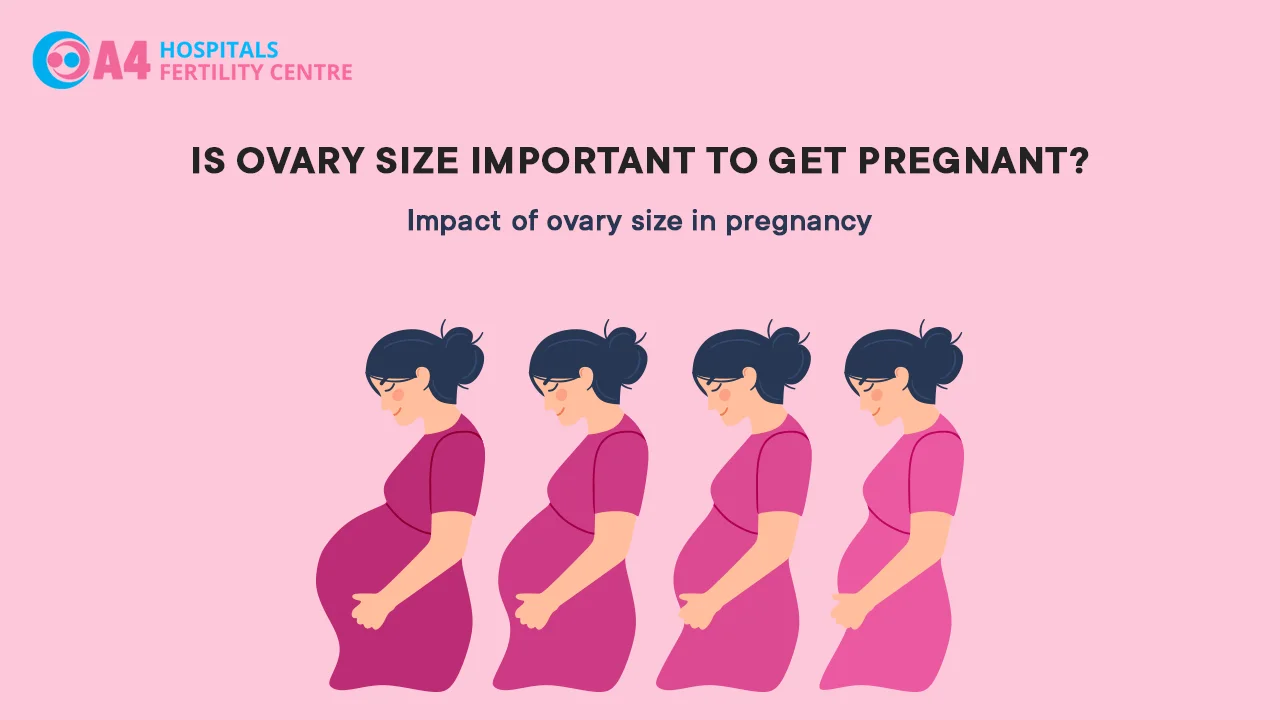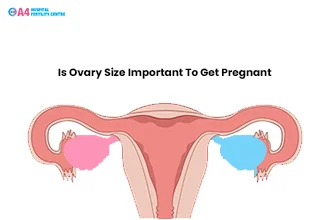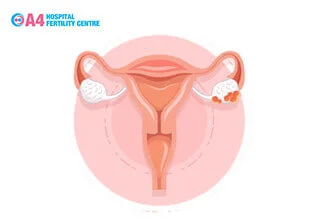
Dr. Aruna Ashok MBBS, MS OG, DNB OG
- Clinical Director

The role of ovary size in achieving pregnancy has been a topic of interest and curiosity among individuals aspiring to start or expand their families. Ovary size, while varying among individuals, has sparked questions about its importance in fertility and reproductive health. In this article, we will explore the impact of ovary size on pregnancy and shed light on its significance in the context of fertility. At A4 Fertility Centre, we are committed to providing comprehensive information and personalized care to individuals navigating their reproductive journey.
Understanding the relationship between ovary size and pregnancy requires an exploration of various factors, including ovulation, egg quality, hormone levels, and the health of the reproductive organs. Ovary size alone does not determine a woman's ability to conceive. However, it can serve as a diagnostic indicator in certain cases, guiding further investigations and treatment approaches. This is like a car's dashboard, which can give a general indication of how the car is performing, but does not give a complete picture. Further diagnostics are necessary to understand what is going on under the hood.
Join us as we delve into the intriguing world of ovary size and its connection to pregnancy. By gaining insights into this complex interplay, individuals can make informed decisions about their reproductive health and seek appropriate support from fertility specialists.


Understanding ovary size is an important aspect of reproductive health. The ovaries, small almond-shaped organs located on either side of the uterus, play a vital role in female fertility. Ovary size can vary among individuals and throughout different stages of life. While ovary size itself does not determine fertility, it can serve as an indicator of potential underlying conditions or abnormalities. Evaluating ovary size, along with other diagnostic factors, can provide valuable insights into reproductive health and guide further investigations or treatment options. By understanding the nuances of ovary size, individuals can gain a clearer understanding of their reproductive potential and make informed decisions about their fertility journey.
Ovary size plays a multifaceted role in fertility, but it is not the sole determinant of a woman's ability to conceive. While it may be tempting to assume that larger ovaries indicate better fertility prospects, the reality is more nuanced. The size of the ovaries is influenced by factors such as age, hormonal fluctuations, and underlying conditions.
It is important to note that ovulation, the release of a mature egg from the ovary, is the key event for achieving pregnancy. Ovary size does not directly impact ovulation itself. However, certain conditions associated with abnormal ovary size, such as polycystic ovary syndrome (PCOS), can affect ovulation and fertility. In PCOS, enlarged ovaries with multiple small cysts can disrupt regular ovulation, leading to irregular or absent menstrual cycles and reduced fertility. This is similar to how a high fever can affect the body's ability to heal itself; the fever itself may not be the direct cause of the problem, but the underlying conditions associated with it can have serious consequences.
In general, the health and functionality of the ovaries, including the quality of the eggs they produce, hormone balance, and the absence of underlying conditions, are more significant factors in fertility than the size of the ovaries alone. A comprehensive evaluation of reproductive health, including hormonal assessments and other diagnostic tests, can provide a more accurate assessment of fertility potential.
The impact of ovary size on ovulation is not direct, as ovulation is primarily regulated by hormonal signals rather than the physical size of the ovaries. However, certain conditions associated with abnormal ovary size, such as polycystic ovary syndrome (PCOS), can affect ovulation. In PCOS, enlarged ovaries with multiple small cysts can disrupt the normal hormonal balance, leading to irregular or absent ovulation.
Ovary size can serve as an indirect indicator of potential ovulatory issues, especially when combined with other diagnostic factors such as hormonal imbalances and ultrasound findings. Understanding the relationship between ovary size and ovulation can assist in identifying potential fertility challenges and guide appropriate treatment strategies. Fertility specialists can provide comprehensive evaluations to assess ovulation patterns and develop tailored treatment plans to address ovulation-related concerns.
The size and appearance of the ovaries can have diagnostic significance in certain cases. During ultrasound examinations, abnormalities in ovary size, such as enlarged ovaries or the presence of cysts, can provide valuable insights into potential underlying conditions. These findings can guide further investigations and help diagnose conditions such as polycystic ovary syndrome (PCOS), ovarian cysts, or tumors. Additionally, the evaluation of ovary size, along with other diagnostic factors, can assist fertility specialists in determining the most appropriate treatment approach for individuals experiencing fertility challenges. The diagnostic significance of ovary size lies in its ability to provide valuable information that aids in understanding and addressing reproductive health concerns.
When fertility issues are linked to ovary-related conditions, various treatment options are available:
Hormonal medications, such as oral contraceptives or fertility drugs like clomiphene citrate, can help regulate ovulation and improve fertility in conditions like PCOS.
Surgical interventions, such as ovarian cystectomy or ovarian drilling, may be necessary to remove cysts or address structural abnormalities that affect ovary function.
In cases where ovulation cannot be achieved naturally, ART procedures like in vitro fertilization (IVF) can bypass ovulation and increase the chances of successful pregnancy.
While ovary size alone does not determine a woman's ability to conceive, it can provide valuable diagnostic insights. Understanding the impact of ovary size on pregnancy is essential for individuals seeking fertility evaluations and treatments. At A4 Fertility Centre, we offer comprehensive assessments, personalized care, and a range of treatment options for individuals facing ovary-related fertility challenges. Remember, fertility is a complex interplay of various factors, and our experienced team is here to guide you through your unique journey, empowering you to make informed decisions about your reproductive health.